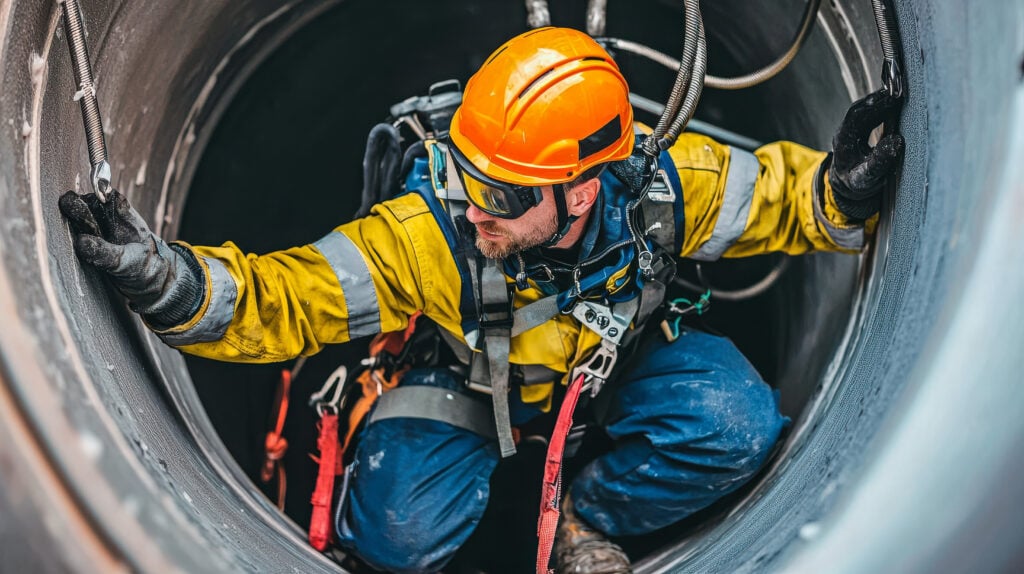A single step into an untested space could be your last. That’s why confined space safety is non-negotiable—it’s the difference between a planned work event and a crisis. These spaces look harmless until they fight dirty, and they often contain invisible killers like oxygen deficiency or toxic vapors. This guide breaks down the absolute must-know protocols, roles, and tests you need before you even think about opening that hatch.
Confined spaces look harmless until they fight dirty, let’s break down what you’re really walking into.
Confined spaces are some of the most hazardous environments in the workplace. These spaces are not designed for continuous occupancy and often present significant risks, including oxygen deficiency, toxic atmospheres, and entrapment hazards. Proper preparation, training, and adherence to OSHA standards are critical to ensure the safety of workers entering these environments. Here’s everything we’ll cover together:
- Understanding confined spaces and the hazards they present.
- Key roles and responsibilities of the entry team.
- Acceptable entry conditions and atmospheric monitoring.
- Emergency response and rescue protocols.
- Methods to ensure compliance with OSHA standards.
First things first, what even qualifies as a confined space and why is it trying to kill you?
A confined space, as defined by OSHA, has the following characteristics:
- It is large enough for an employee to enter and perform assigned work.
- It has limited or restricted means of entry and exit.
- It is not designed for continuous employee occupancy.
The primary hazards of confined spaces include:
- Atmospheric Hazards: Oxygen deficiency, flammable gases, and toxic vapors.
- Engulfment Hazards: Flowable substances, such as grain or sand, can trap or suffocate workers.
- Configuration Hazards: Narrow openings and irregular shapes can make escape difficult.
It takes a dream team to enter safely, here’s who does what on your confined space squad.
- Entry Supervisor:
- Ensures a safe entry plan is in place.
- Confirms all pre-entry measures, such as atmospheric testing, have been completed.
- Cancels the permit if hazardous conditions arise.
- Attendant:
- Stays outside the confined space and monitors the workers inside.
- Maintains communication with entrants at all times.
- Alerts the entry supervisor in case of emergencies or hazardous conditions.
- Entrants:
- Follow all safety protocols and wear required PPE.
- Continuously monitor conditions inside the space and communicate with the attendant.
- Exit the space immediately if unsafe conditions occur.
Before you dive in, the air better be clean and the rules better be tighter than your harness.
Atmospheric Testing Requirements:
- The air inside the confined space must be tested for:
- Oxygen Levels: Must remain between 19.5% and 23.5%.
- Flammable Gases and Vapors: Levels must remain below 10% of the lower explosive limit (LEL).
- Toxic Substances: Must not exceed permissible exposure limits (PELs) set by OSHA.
Ventilation and Isolation Measures:
- Confined spaces should be ventilated to remove hazardous air and maintain safe oxygen levels.
- Isolation: All energy sources—electrical, mechanical, hydraulic, or pneumatic—must be shut off and locked out following Lockout/Tagout procedures.
- Rescue: Rescue equipment and emergency protocols must be in place and ready to go before anyone enters.
Permit to enter: Your golden ticket to confined space safety.
A written entry permit is mandatory. It ensures that all hazards have been assessed and controlled before entry. The permit must:
- Specify the location, date, and purpose of the entry.
- List the authorized entrants, attendants, and supervisors.
- Document the results of atmospheric testing.
- Detail all necessary isolation measures (LOTO) and rescue services.
No permit, no entry. It’s the law and the best defense against a catastrophic accident.
Frequently Asked Questions About Confined Space Safety
What are the three defining characteristics of a confined space?
A confined space is defined by three things: 1) It is large enough for an employee to enter and perform work. 2) It has limited or restricted means of entry and exit. 3) It is not designed for continuous employee occupancy.
What is the most important role in a confined space entry team?
While all roles are critical, the Attendant holds the most crucial non-entry role. The Attendant must remain outside the space, maintain communication with the entrants at all times, and call for emergency services or trigger the non-entry rescue process if conditions become unsafe. They are the lifeline to the team inside.
What is the required range for oxygen levels inside a confined space?
For safe entry, the oxygen level inside the confined space must be within the acceptable range of 19.5% to 23.5%. Levels below 19.5% are considered deficient and pose an immediate risk of asphyxiation.
References
- Occupational Safety and Health Administration (OSHA) – Confined Spaces
- National Institute for Occupational Safety and Health (NIOSH) – Confined Spaces

